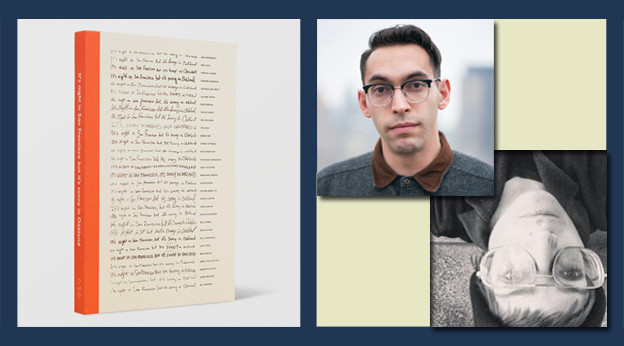Re(con)figuring the moment
A review of 'It's Night in San Francisco But It's Sunny in Oakland'

It’s Night in San Francisco But It’s Sunny in Oakland
It’s Night in San Francisco But It’s Sunny in Oakland
What are your living conditions, do they feel stable?
Who do you consider your community, is it endangered?
“I do not want to convince you to do one thing or the other. I am trying to figure some-thing out” (Juliana Spahr).
Coming out of the atmosphere that gave fruit to the East Bay Poetry Summit, and released at the second, It’s Night in San Francisco But It’s Sunny in Oakland addresses the stressed, urgent, inexorable “now” of Oakland and provides a document of community on the verge. Of despair, of disappearance, of action, of cohesion, of coherence. Of falling, of flying? Is the form poetry? Experimental fiction? Inter-genre? We don’t know, who cares, it doesn’t matter.
As an object, It’s Sunny is equal to the test in the way it expresses the agility of the means we have, the robustness of available forms to respond quickly, usefully, beautifully to the requirements of the moment. The cover displays the handwriting of many of the participants transferred to a polymer plate, letter-pressed. Part hand-constructed, part rough, part glossy.
The table of contents is a roll call, names bright white on the black of the page, which nonetheless feels friendly, too, in its inverse relation to a rounded sans-serif font. It is part yearbook, altogether greater than the sum of pieces, showing living (poetry?) as organism, and all the hope and fear and friendship and fraught alliances of community and “community” drawn together under economic and political and interpersonal stresses. There are gentle moments in the uproar, critiques of the quietude, calls to violence, aesthetic experimentation.
Many pieces address directly or elliptically the economic reality of Oakland and the Bay area, the urges and impulses there. Throughout, there are numbers, names, materials, photographs, price points, anxieties about the inevitable untenability of living situations.
The saying is urgent precisely because of the prevalence of not saying, because of the potential for nonrepresentation that obscures political reality. It’s Night in San Francisco But It’s Sunny in Oakland does discovery for a language that could learn again to signify. It comes out of a necessity of recording something that feels endangered, marked with precarity, a moment already at least partially over, coming as it does post-Occupy and in the wake of two authors represented within who have since lost or nearly lost their jobs ostensibly for participating in attempts to unionize a supposedly liberal institution.
Zoe Tuck brings avant-garde insistence on materiality of language and Steinian philosophical musicality to bear on pointing into the world again, a world which, precarious, demands indication. The influence of Lisa Robertson’s Office for Soft Architecture seems also present:
Time may circle or spiral but one must eat and sleep
within four walls if one can, one must find a way of getting by
and this means a straight line to the right or East if you prefer,
where money gathers in vertical chambers
As Jack Frost says, “David said that is it not only overcoming the amnesia of the present, but the present’s hermeneutics, to which we are tasked as such slender archivists.”
But there is less of a unified goal here than suggested. Kate Robinson’s “Preliminary Pattern Study,” for example, is a particularly dense, knotty, and well-rooted example of visual poetry.
Many voices raised together are either chanting or wailing or song, and It’s Sunny is a bit of a chanty wail song. A music of divergent voices that provides some sanity in acknowledgement, comfort in conversation, relief in documentation, investigations into letterforms, a rhythm to labor by, to be honest with.
“We,” as in the “we” of the book, document as we goes, tentacled into institutions, homes, and provisional hidey holes wherever possible, whenever necessary, however it’s fun, a record of trying to hold hearts open in a deluge of news, of streets in conflict, before taking shelter in the quasi-hermetic private property of continuous basement shows, backyard reading series, rooftop gatherings, each other’s beds.
“It’s night in San Francisco but it’s sunny in Oakland” as a phrase remains somewhat opaque, object turned icon, discovered under the couch a week after the party ended. Pieces, at times, written for or between friends, may with distance lose and gain powers of signification. In any case, one enjoys being whispered to.
As a collection, it is messy, alive, unmannered, sun-soaked, salty, smoking, wrapped in caution tape. Of the moment. Of the moment of last summer. Of a moment that feels like it will always feel like last summer.
“We,” readers, are invited to be stitched in. The phrases, under-over-through, stitch us.